Table of Contents
- The Challenges of Selling AI Products Today
- How to Sell AI Products in a Competitive Market
- Best Practices from Sales Experts
The Challenges of Selling AI Products Today
The ever-growing interest in AI would have anyone believe that selling an AI product would be straightforward. It seems like everyone is talking about AI, and it is logical to assume that everyone is interested in buying and using AI.
However, the data suggests that AI adoption has plateaued, which gives reason for the challenges and apprehensions that sales teams are facing.
AI adoption has plateaued
Google Trends data shows a rapid increase in searches for terms related to AI, but even search plateaued in June 2023.
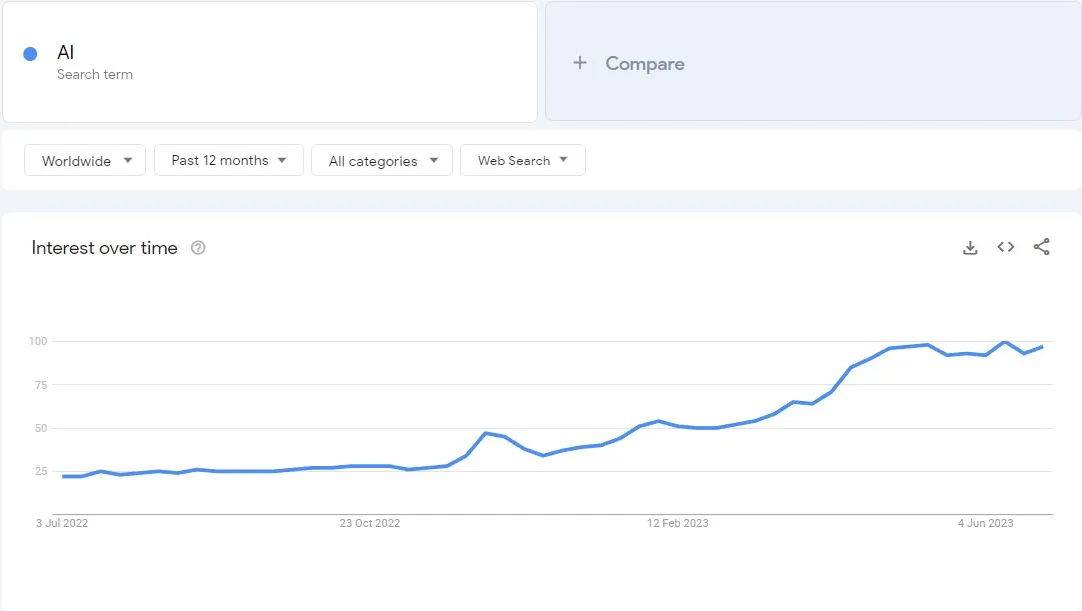
Interestingly, McKinsey’s Global Survey on AI found that adoption was more prominent between 2017 and 2018, when it more than doubled. Between 2019 and 2022, AI adoption plateaued.
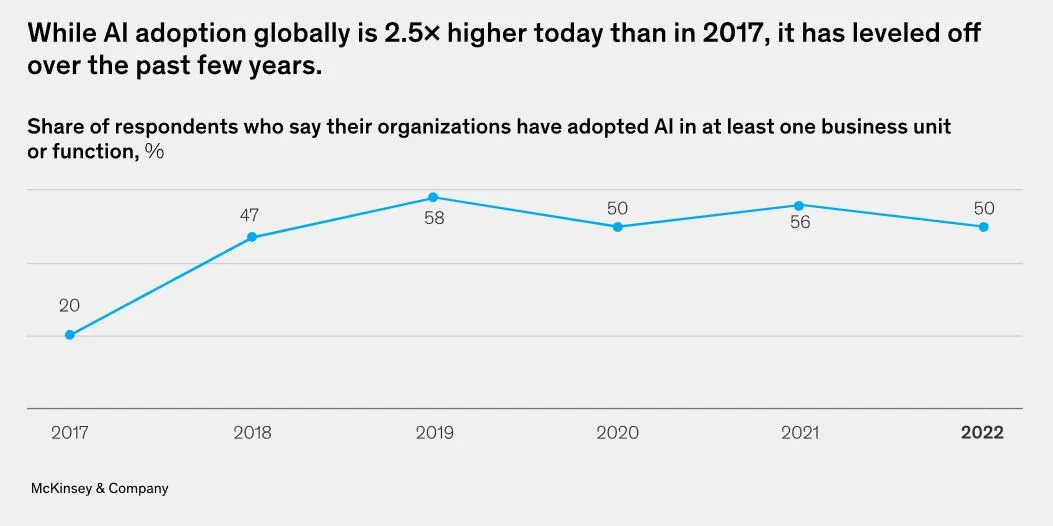
No doubt, this plateau is a challenge sales must overcome, and perhaps the reason for this plateau is a combination of many challenges.
Trust and Understanding
In HubSpot’s The State of AI in Marketing, results showed that only 27% of marketers are very confident that the information generative AI produces is accurate.
Marie Brunet, global vice president of sales at Uniphore, supports this. Brunet finds that a major challenge in selling AI is trust and understanding. “Many people see AI as a black box absorbing their data with a possibility to provide inaccurate results full of biases and lack of privacy and transparency,” she says.
Unrealistic Expectations
The unrealistic expectations around AI are strong on both sides.
Yogesh Joshi, head of growth at Kommunicate says, “With the launch of LLMs like ChatGPT and Bard, customers today are much more aware of the technology and sometimes have overly high expectations of what can be achieved with it. However, what needs to be understood is that there are still many limitations to this technology.”
Equally, entrepreneurs are showing some reluctance to use AI to its full potential. In her Forbes article, Jodie Cook says, “Some entrepreneurs are afraid of AI. They see it as their competition, and they are worried their margins and USPs are being squeezed by the technology.”
Cook claims that many businesses are not thinking big enough when it comes to adopting AI into their business.
The data hopefully brings some peace for salespeople. The buzz for AI is bigger than the adoption, and selling AI products isn’t as easy as we might believe. However, there’s no doubt that businesses leveraging AI benefit from automated workflows, virtual assistance, and data analysis at scale.
AI isn’t going anywhere, and those who master the art of selling AI in a competitive space will flourish. The trick is understanding the buyer's apprehensions and challenges and how to overcome them.
How to Sell AI Products in a Competitive Market
Now we know some of the major challenges that you need to overcome, let’s look at how some brands and experts are positioning their AI.
Share the Benefits
AI is here to solve problems and make the lives of those that use it easier. If you want to sell an AI product, you need to share the benefits. It’s a sales tactic that we’re all familiar with, and positioning AI is no different, especially when there are apprehensions about exactly what it can do.
Focus on the benefits to the user. The screenshot below is taken from HubSpot’s artificial intelligence page. Messaging focuses on the ways in which AI helps the user, listing clearly what it can do.
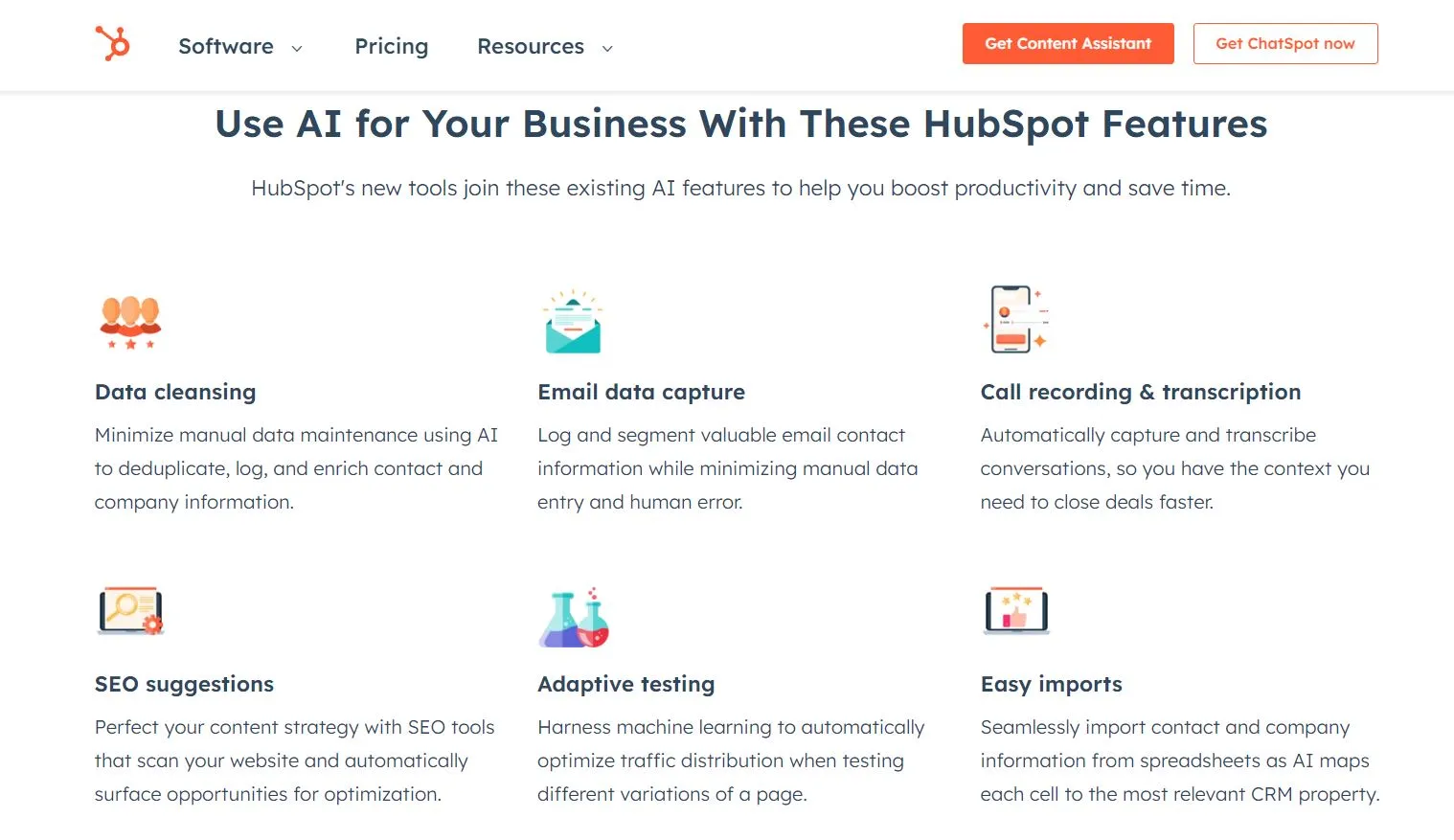
This approach is used across the web. Take a look at Superhuman, an email ai that lists three core benefits to the user.
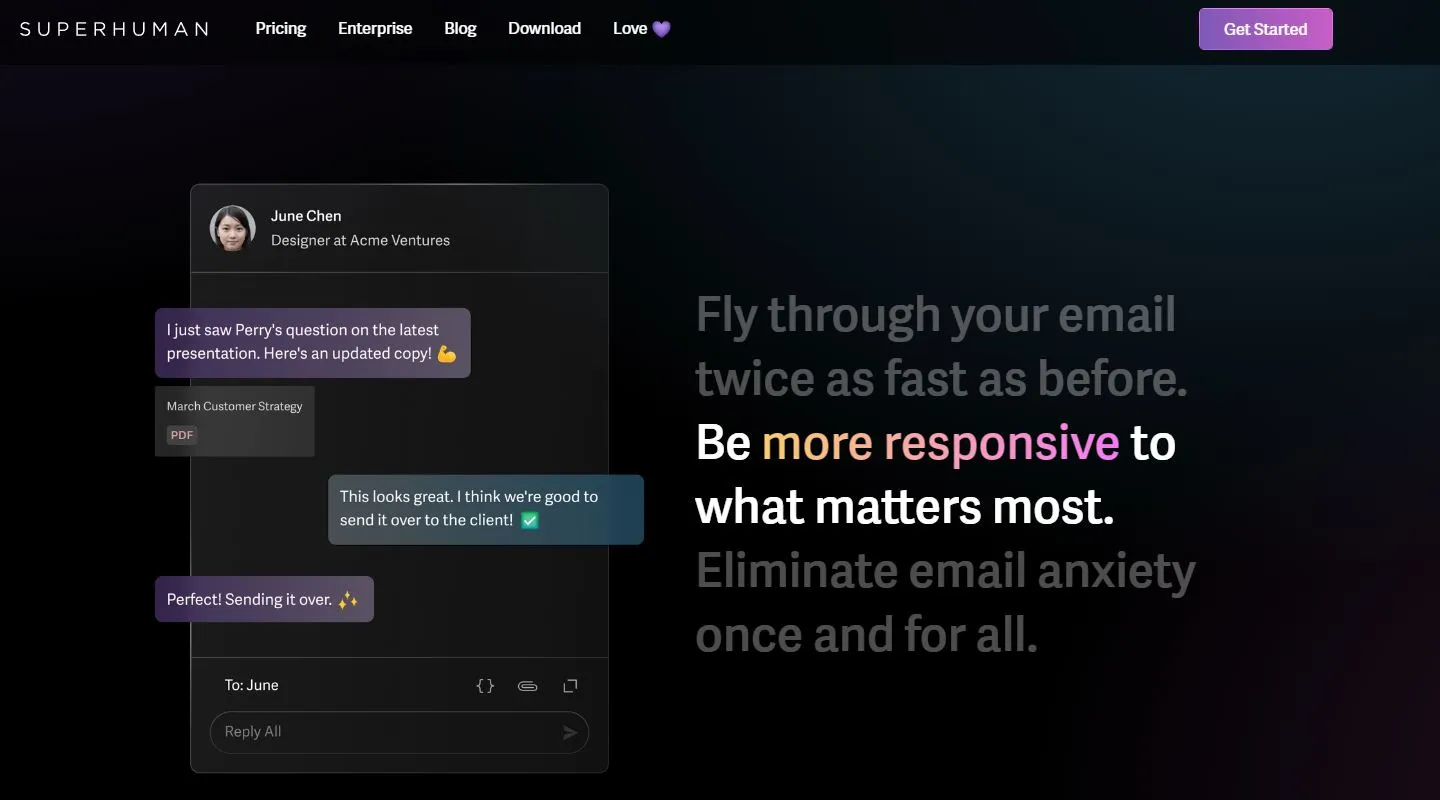
Emphasize AI ROI
Chad Burmeister, founder and CEO of BDR.ai, recommends taking benefits one step further. He recommends that sales professionals should focus on the outcomes that AI provides instead of the features of AI.
“For example, BDR.ai Reachout delivers 800 connection requests per month, 300 new connections, 40-80 replies, and typically five or more monthly meetings for $250-$500,” he says. "The comparable cost for a traditional BDR would be $7,000 monthly for 8-12 meetings. The outcome: $100 meetings versus $700/meetings.”
Emphasizing AI ROI is more likely to help salespeople close. Brunet says, “Like any new technology, AI implementation must be linked to a concrete business case that’s a priority for the client. In a market where budgets are getting highly scrutinized, AI initiatives must be linked to concrete ROI and measurable success metrics.”
Educate Your Prospects
ChatSpot is a new addition to the HubSpot CRM, available on free plans and up. Like any new AI product, sales must actively educate prospects on exactly what the product is and how it supports business.
Naturally, ChatSpot’s landing page includes all the benefit statements. However, it also shares – with images — four key ways ChatSpot works.
Plus, the page shows how HubSpot is better with the ChatSpot integration. The section “Better with HubSpot” shares four tabs with four desirable reasons for users to integrate ChatSpot.
.webp)
Consider a Freemium Model
If we’re looking into what makes a successful AI product sale, it makes sense to look at ChatGPT, which gained one million users within five days of launch.
ChatGPT started off free for everyone. It was enough for ChatGPT to go viral and build interest. Later, ChatGPT introduced ChatGPT Plus, a paid model where subscribers gained special benefits like
- Faster response times.
- Access to ChatGPT at all times.
- New features and improvements, such as ChatGPT-4.
A freemium model may help your sales personnel reach a wider audience, those who don’t quite have the budget or need to be persuaded by what your tool can do. Free access eliminates budget constraints and gives prospective users the freedom to see the benefits for themselves.
Address Misconceptions and Differentiate
Oliver Goodwin, CEO and founder of Synthesys believes that the key to selling AI is differentiation.
He says, “It is crucial to highlight the unique features and advantages of your AI solution compared to competitors. This can be achieved through in-depth market research and understanding customer pain points."
You can demonstrate use cases in many ways. A common approach is to create use case pages on your site; see how Synthesys do this for branding videos below.
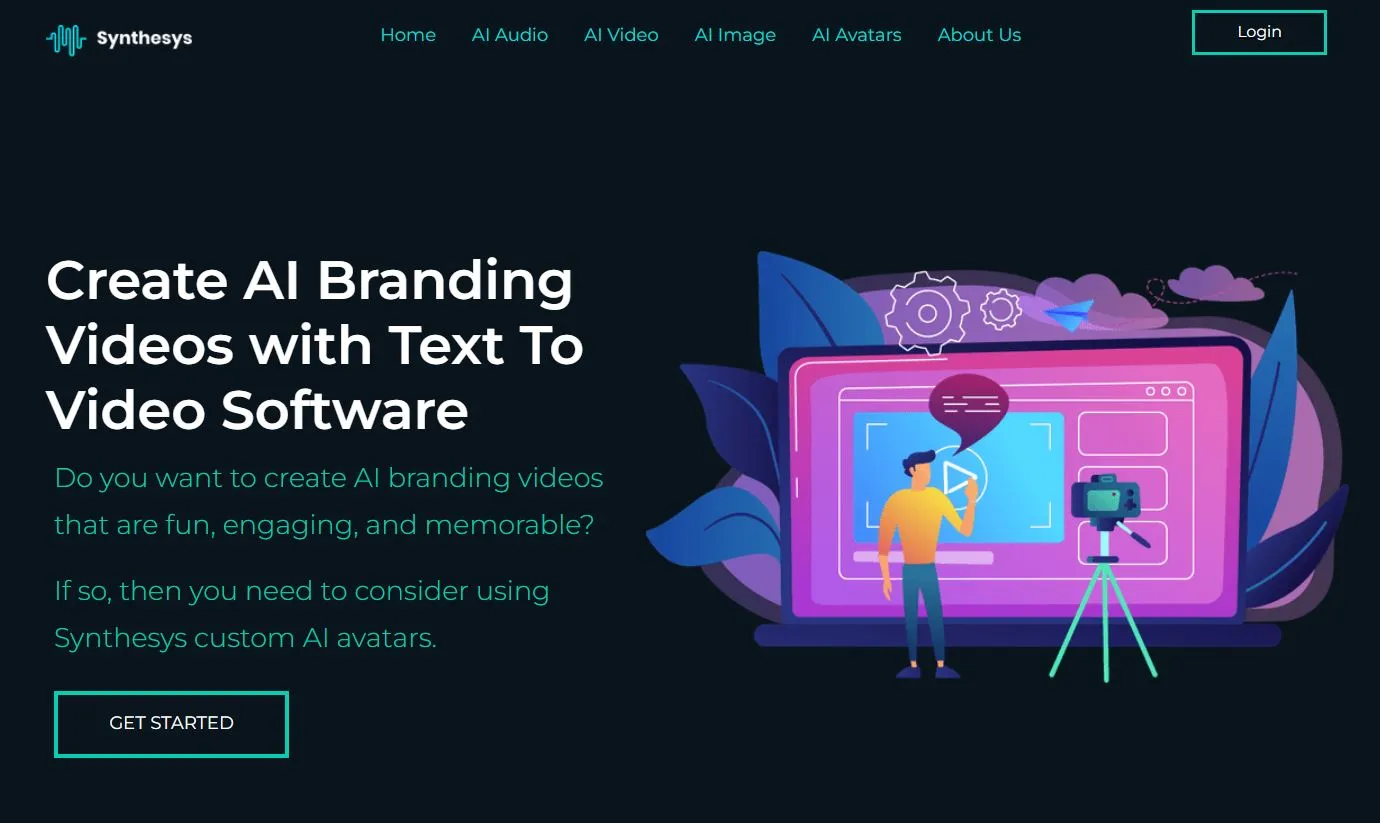
Another practical approach is video. If prospective buyers can see exactly how an AI tool can support them daily, they might be more compelled to buy.
Brand Partnerships
Jasper.ai is an AI writer, and Surfer SEO helps users write SEO-optimized articles. The two tools had a common goal with individual offerings. The partnership between Jasper and Surfer increased the efficacy of each tool.
People using Jasper could gauge SEO success through a Surfer integration, and those using Surfer could adopt an AI content writer, Jasper, to make writing easier and faster.
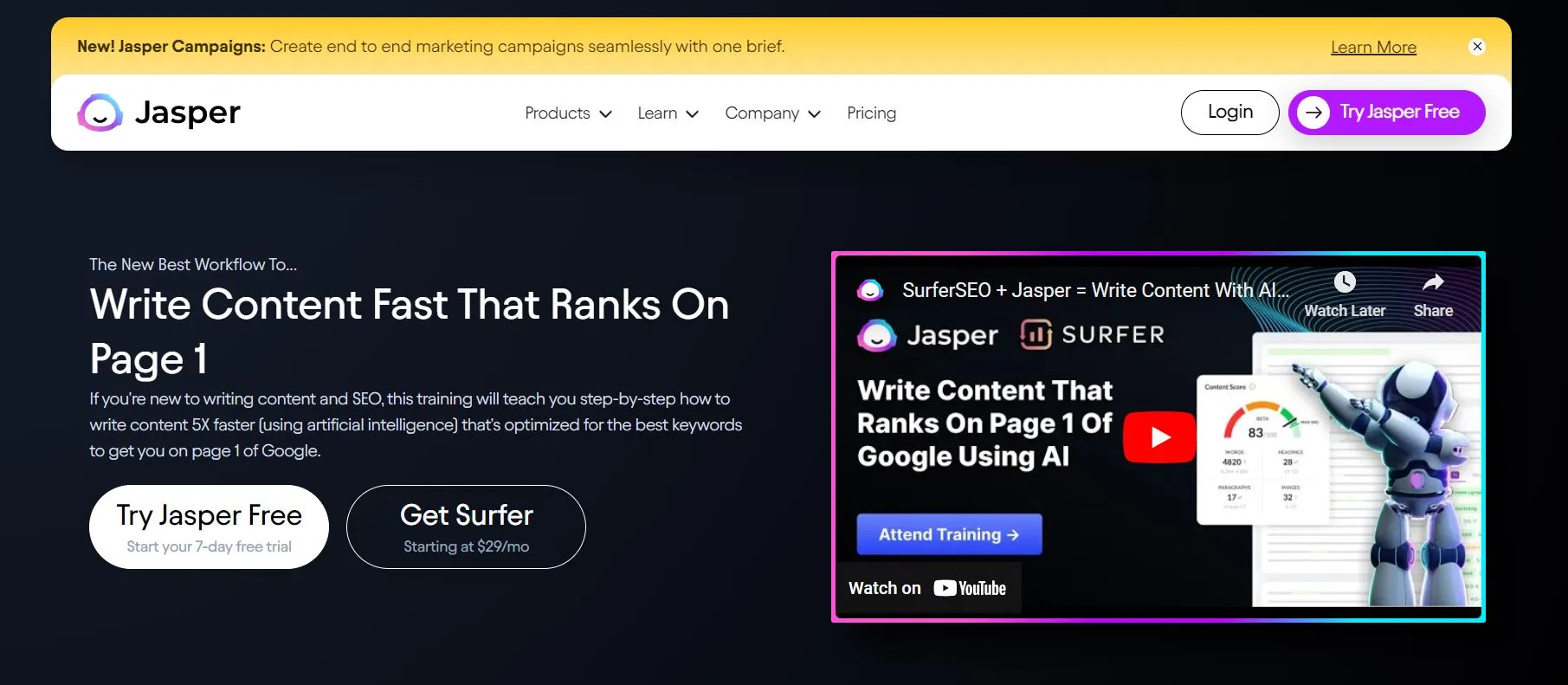
Brand partnerships such as this help share audiences between two platforms. Users are likely to try the recommended tool, as there’s an easy integration.
The sales pipeline is straightforward. Plus, the adaptation of the second tool is expected to be helpful since the user is already in flow with a process that’s optimized with the introduction of a second tool. Plus, there’s already trust in the recommendation from the first tool.
Each tool has a page on its site dedicated to promoting the integration and, therefore, the other tool.
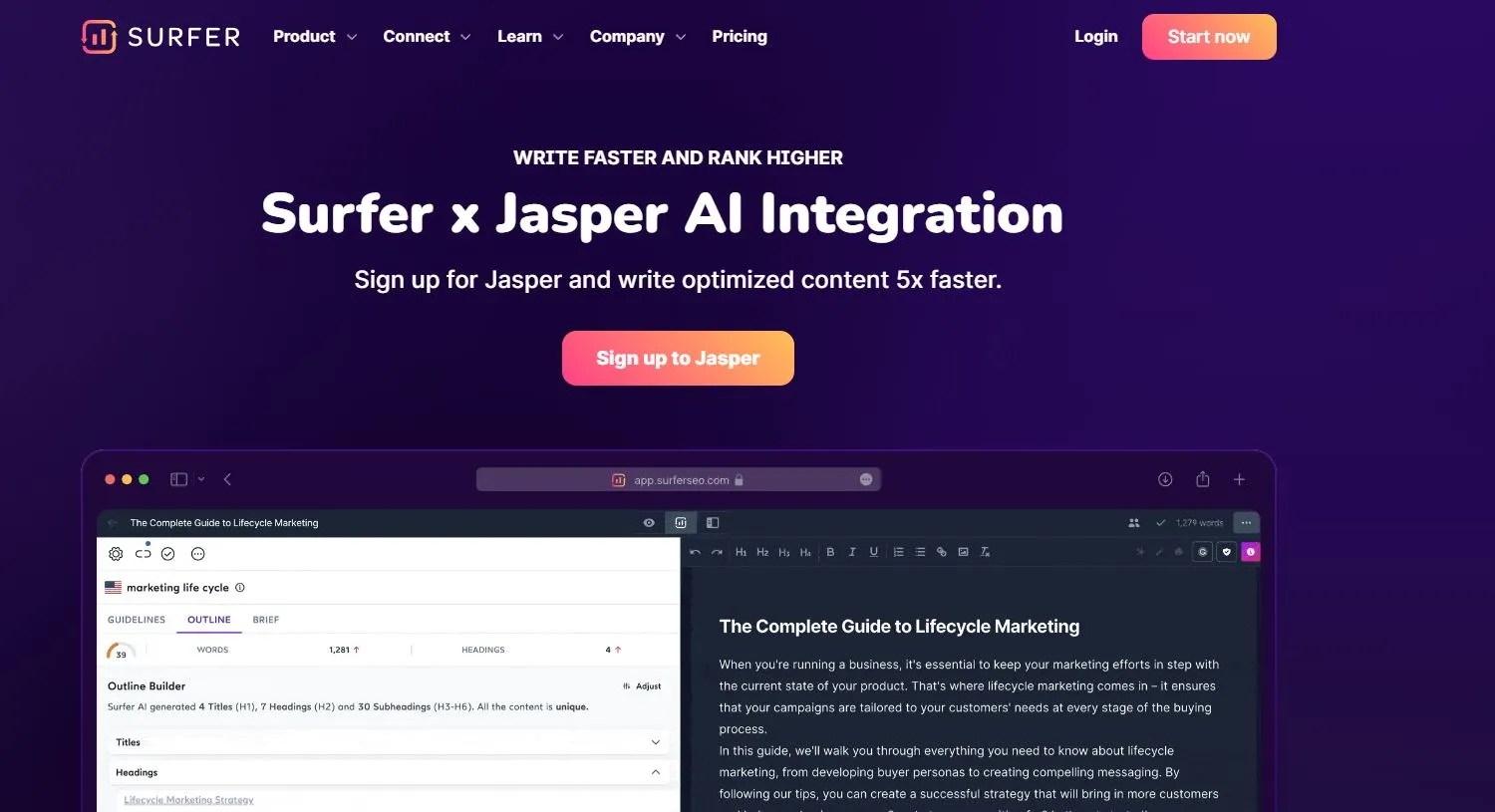
Use partnerships to share audiences and aid your sales process. A partnership clearly defines how the tools support and improve each other.
Demonstrate AI With Prospect Data
Jenn Deering Davis, co-founder and head of marketing at Gradient Works says, sales reps need to be prepared to show prospects how their particular AI product works with data.
“You should show prospects and prove your claims with concrete demos using prospect data. That will help you win out over the noise of the magic sparkle AI claims prospects are bombarded with,” Davis says.
Salesforce does a great job of this through success stories. In the screenshot below, you can see their success story hero, headlining Xero’s success with their AI CRM.
The success story leads with the scale of their success (transforms service for more than 2 million customers). Plus, it draws out more data, such as a 20% increase in average speed to answer. As Davis says, data proves your claims and helps you stand out.
.webp)
Best Practices from Sales Experts
Finally, we have four tips from sales experts for the most conscientious sales teams who share how they’re selling AI.
1. Set Realistic Expectations
Yogesh Joshi of Kommunicate advises that sales teams should set realistic expectations for prospective buyers.
As mentioned above, some AI adopters under (or over) estimate the capabilities of AI.
Joshi says customers need to understand that there are still limitations to this technology.
“The only way to handle it is by educating customers about the current capabilities and limitations of the technology and setting realistic expectations right from the beginning,” Joshi says. “Offering full-access trials and showing through POCs can really help here.”
Pro tip: Don’t forget to consider a freemium model or, as Joshi recommends, offer a full-access trial.
2. Provide Solutions
Joshua Kaiser is the AI, automation technology expert, and CEO at Tovie AI. The company specializes in developing digital assistants, including voice and chatbots. Kaiser says the company faces a knowledge gap. Customers know AI is important but are unsure of how to leverage it effectively.
“This is why we provide not only products and solutions but also consulting services that educate enterprises about the fundamentals of conversational AI,” Kaiser says. “We also advise them on how to implement it effectively into their existing processes.”
Pro tip: Your after-sales service is key to success. Once you’ve sold your AI, it’s important to have some availability for consultancy or robust onboarding so that your users get the most out of their new AI tool.
3. Understand Customer Concerns
Kaiser warns that some organizations are still hesitant to adopt AI because of an emerging concern that bots will completely replace people in the workplace. This makes them reluctant to implement something that might lead to job loss.
When tackling this issue, Kaiser explains “that conversational AI is more about increasing productivity in the workplace, freeing workers from mundane tasks so they can focus on higher-value activities.”
Pro tip: Any good salesperson understands their buyer's core concerns and apprehensions. If your sales process can soothe concerns, you can expect to be more attractive to your buyers. Work to understand buyer pain points deeply so you can address them as early as possible within the sales process.
4. Be Transparent
Brunet of Uniphore, recommends that sales personnel are transparent. She says, “Be as transparent as possible on the data you collect, who keeps ownership, and how it’s being treated. Businesses that offer enterprise-grade security, have a focus on ethical AI, and are transparent with their clients will come on top.”
Pro tip: Transparency from the beginning of the sales process is key. Transparency in AI is not only ethical but necessary for sales. The more a prospect feels they can trust you, the more likely they are to engage with the product you’re selling.
The Future of Selling AI Products
AI adoption may have plateaued, but there’s every reason to see that the future of AI is strong.
The AI products that will stand out in competitive markets will be transparent, solution-orientated, realistic with expectations, and deeply know their buyers.
Use the expert tips and examples from the most successful AI products to support your sales system.
Sales Strategy



.png)

![7 key sales challenges to prepare for in 2026 [+ how you can overcome them]](https://53.fs1.hubspotusercontent-na1.net/hubfs/53/sales-challenges-1-20251023-788058.webp)
![How B2C sales could shift in a recession [new data]](https://53.fs1.hubspotusercontent-na1.net/hubfs/53/Recession%20sales%20strategies%20(1).png)
![22 Best Sales Strategies, Plans, & Initiatives for Success [Templates]](https://53.fs1.hubspotusercontent-na1.net/hubfs/53/Best-Sales-Strategies-1.png)
![What Is Sales? A Quick Guide [+ Examples]](https://53.fs1.hubspotusercontent-na1.net/hubfs/53/what-is-sales-1-20250411-8755735.webp)

![What Is Cross-Selling? Intro, Steps, and Pro Tips [+Data]](https://53.fs1.hubspotusercontent-na1.net/hubfs/53/ft-cross-selling.webp)

